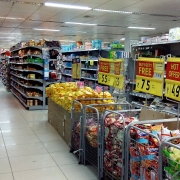Online Grocery Shopping: India in the Global Context
[Excerpts from “Online Retailing Paired with Kirana—A Formidable Combination for Emerging Markets” by Prof. Piyush Kumar Sinha, Srikant Gokhale and Saurabh Rawal in Customer Needs and Solutions (2015) 2:317-324]

The physical retail landscape (the fourth factor) in India and China is very different to that in more developed countries.While in many countries, online retailing arrived long after large-format retailing was well entrenched, it came much sooner in India and China. With access not being limited by geography and online retailers providing a wide range of products at very attractive prices, the online format has found acceptance in smaller towns and rural areas where large-format retailing is yet to enter. In India, almost 40 % of the sales of many large online stores come from small and medium-sized towns and rural areas which are not being serviced by large format retailers.

There are more than 14 million physical stores in India,constituting more than 99 % of small retailers. About six million of these are small kirana stores. Leading national and regional brands reach more than 75 % of these stores through direct and indirect channels. In the period 2008–2013, store based retailing in India generated about $435 billion in revenue and non-store retailers about $5 billion; store-based retailing grew at a CAGR of 6 %, whereas the rate for non-store based retailing was 15%1. Large-format chain retailers have found it challenging to grow and become profitable;one of the primary factors has been the steep rise in real estate prices, which comprise up to 10 % of sales in India as compared to 3–4 % in developed economies2. The availability of good retail spaces is low, despite more properties being developed. Wherever hypermarkets have low penetration, online stores have found wider acceptance1.

Five circumstances seem to necessitate a new business model. These are disruptive solutions, new technology, markets that require continuous refinement or customization,fending off disruptors and responding to a shifting basis of competition3. Online retailing is one such disruption,which has forced all formats of retailing and multiple categories of product sellers to rethink their business models.Retailers have innovated with their business models to enhance value creation and appropriation beyond the levels afforded by traditional approaches to retailing4. They tend to operate around customer value proposition, profit formula,key resources and key processes to differentiate themselves.

References:
- http://knowledge.wharton.upenn.edu/article/online-groceries-in-india-will-consumers-bite/, accessed on November 21, 2018
- Venkatesan R, Kumar V, Ravishanker N (2007)Multi channel shopping:causes and consequences. Journal of Marketing 71(4):114–132
- Johnson MW, Christensen CM, Kagermann H (2008) Reinventing your business model. Harvard Business Review 86(12):51–59
- Sorescu A, Frambach RT, Singh J, Rangaswamy A, Bridges C(2011) Innovations in retail business models. Journal of Retail 87S(1):S3–S16
Related Resources:
- Brand adoption by BoP retailers, Prof. Piyush Sinha, Suraksha Gupta and Saurabh Rawal, Qualitative Market Research:An International Journal Vol. 20 No. 2, 2017 pp. 181-207 Available for download
- Format Choice of Grocery Retailers, Prof. Piyush Sinha, Elizabeth Mathew and Ankur Kansal, 2005 Available for download
- Store Choice Behaviour in an Evolving Market, Prof. Piyush Sinha and Prof. Arindam Bannerjee, International Journal of Retail & Distribution Management; 2004; 32, 10; ProQuest pg. 482 Downloadable on request
- Business Models in Retailing, Prof. Piyush Sinha, 2016 Downloadable on request











Leave a Reply
Want to join the discussion?Feel free to contribute!